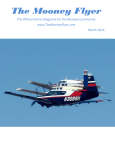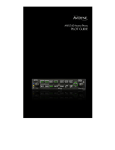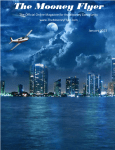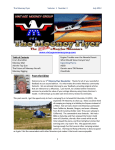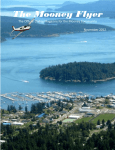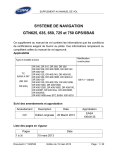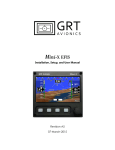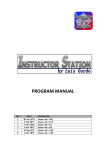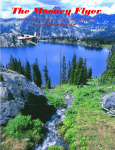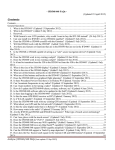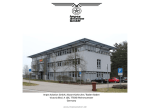Download February, 2013 - The Mooney Flyer
Transcript
The Mooney Flyer The Mooney Flyer Volume 2 Number 2 February 2013 The Official Online Magazine for the Mooney Community www.TheMooneyFlyer.com February 2013 1 Back to Table of Contents The Mooney Flyer Volume 2 Number 2 Contents Features Phoenix Rising Could Jet-A piston engines from Continental be a differentiator for a reborn Mooney Aircraft Company? Bob Kromer thinks so Compression Testing Phil Corman writes about the overall value of compression tests vs Borescope analysis, oil analysis and engine monitoring. Editors Phil Corman Jim Price Contributing Writers Bob Kromer Tom Rouch Paul Loewen Linda Corman A Lake Tahoe Trip: Lessons for Instructor and student CFII Geoffrey Lee shares the story of instructing an inexperienced pilot in the Sierra Nevada Mountains. Good info for all of us. When the Belly Scrapes the Runway A must read for all Mooney pilots… except for mechanical issues, there’s almost always 1 reason for this. Did You Know These Things about ForeFlight Jim Price covers some oft overlooked and cool features of ForeFlight STC & PMA Parts for Your Mooney To Subscribe Click Here Another must read article from Paul Loewen at LASAR From the Right Seat Linda Corman shares a Mooney Trip to Palm Springs To Advertise Click Here To Submit an Article Click Here In Every Issue From the Editor Appraise Your Mooney’s Value Website of the Month – SocialFlight Mooney Mail Ask the Top Gun – Tom Rouch answers your questions Upcoming Fly-Ins Have You Heard the News? – Relevant GA news & links for the month Product Review – Avidyne IFD440 and IFD540 FMS/GPS/NAV/COM Classifieds Click Here to Subscribe 2 Click Here For Back Issues Back to Table of Contents February 2013 The Mooney Flyer Volume 2 Number 2 February 2013 Batteries.. batteries With winter upon us, here in the northern hemisphere (respects to our wingmen in Australia), the topic of Batteries and battery life has come up often. Many readers have asked us our opinion, and that is all we have, regarding battery selection and battery care. I think battery issues become more apparent as the temperature drops. There are Concordes and Gills, 12V and 24V, acid and sealed. My own personal experiences have driven me to Sealed Concordes. Why? My two main reasons are 1) They seem to last longer than Gills, 2) They don’t spew lead acid all over my airplane. In my old M20C, the battery was in the engine compartment in a battery box. Right after I bought the plane, I needed to fabricate a new box since it had corroded with acid drippings over the years. With my Eagle, the two batteries are back in the fuselage. I opted to go with sealed Concordes. The batteries are 9 years old and still producing cranking power. In all fairness, I keep the batteries happy by flying often, but I also invested in the BatteryMinder designed for my battery. I plug it in most times when I don’t think I will be flying for a while. The trickle charge followed by the desulphation phase just keeps the batteries at the top of their game. I can’t recommend them enough. This is a dynamic duo! It was easier to test the health of a lead acid battery with the battery turkey baster (my terminology). All I had to do was draw some acid into the baster and it showed me the health of that battery. With sealed batteries, the process is more involved. You charge it until the charger says its complete. Then you put a pre-defined load (amps) on it and measure how fast it depletes. This takes too much energy for me, especially when I can tell from the starting crank speed. The Concorde owners manual informs State of Charge vs. Open-Circuit Voltage (12V battery) 100%: 12.9V or above, 75%: 12.6V 50%: 12.3V, 25%: 12.0V, 0%: 11.7V. Anyway, I’m 9 years and counting on my Concordes…. For what it’s worth. 3 Back to Table of Contents The Mooney Flyer Volume 2 Number 2 February 2013 Magneto Checks Almost all Mooney pilots I know perform magneto checks during run-up. You know the drill. Increase RPM to about 1700, and then switch to LEFT and RIGHT, looking for an RPM drop. You don’t want more than the drop specified in your POH, and you also don’t want zero drop in RPM. Some believe it is also valuable to check the mags after a flight, because a failing mag will reveal itself then. If you don’t get a drop, your #1 culprit is your PLead. I bet most owners don’t realize there are two things they are NOT aware of. First, if you have an Engine Monitor, it is much more useful to look for increased EGTs in all of your cylinders. Second, perform an additional magneto check at cruise. Here’s the other thing about magneto checks. You will get an earlier indication of a magneto on the decline if you perform the magneto check while at cruise altitude. In this scenario, a failing magneto will show its condition sooner than the 1700 RPM ground run-up check. Winter Flying You’ve heard it many times, that winter flying can be the best. In the western United States, the weather is cooler and the skies clear. Desert convection is tamed, permitting smoother flying in the afternoon. The east coast, well, they know. But even there, winter flying can be spectacular. Nothing beats a Mooney-eye view of snow capped mountains. There are a bunch of things that come into play during winter flying for most of us. First is, you should probably throw some survival gear in the back of the plane. If you need to land off airport in the winter, exposure may be more dangerous than your off airport landing. Secondly, remember a few things about your engine and accessories. Colder temperatures bring out the incipient failing parts sooner. Make sure everything is working, especially the important stuff. Third, remember to pre-heat your engine. Out in California, I tend to pre-heat if the temperature is below 25oF. That is probably sooner than I need to do so, especially if I believe the POH. But I’d rather err on the side of being nice to my engine. Don’t ever pre-heat your engine, except when you will fly. Preheating without a subsequent flight is asking for trouble. Think about it. Your warm your engine… don’t fly it… and then let it cool down and manufacture water in the internal engine. Bad! I told my mom I want to grow up and be a pilot… She thought for a moment and said “You’ll need to pick one” 4 Back to Table of Contents The Mooney Flyer Volume 2 Number 2 February 2013 Appraise Your Mooney’s Value Don’t forget about our cool new Appraise your Mooney’s Value using Jimmy Garrision’s valuation. Jimmy is from All American Aircraft, the country’s largest Mooney reseller. We have implemented the models for M20C, M20E, M20G, M20F & M20J. Click on your model to simply complete the valuation. You no longer need paper and pencil. Just another benefit to our subscribers. These forms are currently Beta test quality. Please send errors to us. M20C M20E M20G M20F M20J updated September 2012 www.SocialFlight.com Most of us Mooney pilots are familiar with Airnav.com. It’s info supplied by pilots for pilots and is generally used to find cheap 100LL. SocialFlight is also a pilot-supplied information database. You can list events in map or list format and specify a distance from your home airport, the type of events you are interested in, and a range of dates. You can filter the types of aviation events by categories such as Air Shows, Open Houses, Warbirds, LSA, Organization meeting, FAA seminar, and much more. If you are a member of various aviation associations, you can specify each of them in your profile so that you won’t miss any of their events as well. You can even specify your interests in your profile and then meet other pilots and make new friends. Sounds a little like Facebook for pilots. Best of all it’s free. Give it a run around the pattern. The more pilots that participate, the better the information. There is an accompanying iPhone and iPad app as well. 5 Back to Table of Contents The Mooney Flyer Volume 2 Number 2 February 2013 I am interested to know how you can provide this great Magazine gratis. I think you should have a subscription service due to the excellent content and knowledgeable contributors. Thank you. Don Rowling, Canberra, Australia My husband and I saw a friend's copy of your January "Mooney Flyer". You've put together a stunning publication with loads of great aviation information. We both pretty much read it cover-to-cover and were wondering if it would be possible to get on your newsletter mailing list......even though we fly a lowly C182. Camille Nelson Found you from one of the sites online. VERY NICE magazine... wow.. you really take some time writing this. And I like the flip book format too. Kudos... David Berelsman Congratulation on a full year of the Mooney Flyer! You are doing a great job! I gave up on MAPA few years ago after years of saying no more when reading those articles and such... Keep up a good work. Igor Ucakar On behalf of the iFlightPlanner Crew, I would like to thank Phil Corman and the editorial staff at The Mooney Flyer for their product review of iFlightPlanner. iFlightPlanner was founded on principles of safety and flight planning efficiency. As Phil mentioned in the review, there are countless electronic flight planning resources available to pilots, and all of us who fly have developed a routine that undoubtedly involves a number of them. Unfortunately, such segmented routines introduce the risk of overlooking a critical step or information that can compromise flight safety. We appreciate The Mooney Flyer highlighting the Flight Wizard, our propriety process that intuitively guides pilots through those critical steps (i.e., route planning, certified weather briefs, weight & balance and flight plan filing) to ensure that the duties as pilot in command are confidently fulfilled. Every feature that is highlighted in the review, including the Flight Wizard, was the result of feedback from iFlightPlanner users and we pride ourselves on quickly meeting the needs of an ever-demanding pilot population. We encourage all our members to contact us if there is anything the iFlightPlanner Crew can do to help improve their iFlightPlanner experience, and the same goes for The Mooney Flyer community. Simply visit www.iFlightPlanner.com/ContactUs if you have questions about anything you read in the review, we’ll be happy to help. Thanks again for your interest in iFlightPlanner, we wish everyone well in the New Year! Andy Matthews, Co-Founder & Director I enjoyed Jim’s article on the GCOs. But how can I find out whether one is available at a given airport? 6 Back to Table of Contents The Mooney Flyer Volume 2 Number 2 February 2013 Editor Note: First, the GCO is not part of the FAA Airways and Radio Facilities as they are purchased and installed by local airports. This means that GCO units are not registered as part of the airways and radio facilities listed in the FAA documents and Jeppesen charts. That said some GCO sites are listed in Jeppesen and other airport guides but there is no actual official procedure or requirement for such registration. Joe Have you heard about Wide Area Multilateration? Didn’t think so, and the name tells you nothing, but it’s rather useful for Mooney pilots in mountainous terrain. WAM is an FAA service that has receivers/transmitters in places that radar coverage is not available. It provides performance that is equal to secondary surveillance radar (SSR) in terms of accuracy, probability of detection, and update rate. Accuracy varies as a function of the location of the targets vs. ground sensors. WAM is adaptable to interrogation rates, output modes and output periods. Update rates and probability of detection can be tailored to various applications such as precision runway monitoring (PRM), terminal maneuvering area (TMA) and En-route surveillance. Interrogation rates can be further reduced by passively processing replies to SSR or traffic collision avoidance system (TCAS) interrogations. WAM operates with Mode A/C, Mode S, and Mode S ES, no equipage mandate is necessary. For ADS-B equipped aircraft, WAM provides an ADS-B target report as well as a multilateration target report. WAM can complement ADS-B by providing transitional surveillance for non ADS-B equipped targets, and can be used for ADS-B validation. Now you know! 7 Back to Table of Contents The Mooney Flyer Volume 2 Number 2 February 2013 Phoenix Rising Could emerging Jet A piston-engines from Continental bring the Mooney factory back to prominence? By Bob Kromer Mooney Factory Engineering Test Pilot 1983-1986 Mooney Executive VP and GM 1986-1991 It’s no secret the Mooney community has been operating for several years now without the confidence of knowing there is a fully operational factory to support the fleet. This statement in no way diminishes the heroic efforts of a handful of employees who have been on station inside the factory in Kerrville, Texas, making much needed parts to support the fleet. It also is not meant to diminish the wonderful efforts of the individuals who own, manage and work in the Mooney service center network in the USA and abroad. The service center network coupled with the few employees inside the factory making parts has kept the fleet flying during the past several years. But let’s face it, sooner or later the lack of a viable and operational factory to stand behind the Mooney fleet will become a factor in the continued airworthiness and resale value of the airplanes we love and fly. So, is there a path forward for the Mooney factory to become viable and strong again? Some would say no; the market has left Mooney behind with composite airplanes available with equal or better performance, glass cockpits, roomier cockpits, two entry doors and whole aircraft parachute recovery systems. Some contend the Mooney design is now dated and can never be built in a competitive number of man-hours compared to composite airplanes. Still others say the market for airplanes like the Mooney is over – in the future we’ll be flying either simple, slow airplanes or big turboprops and jets. Hogwash to all of that! There is no reason for the Mooney factory to wither and die. There can be hope in a strategy for the future. The manufacture of spare parts can be drastically increased at the factory, adding profits. There is an excellent chance for success in expanding factory refurbishment services for many of the Mooney models we currently fly. There are compelling reasons why buying a factory refurbished airplane is a good choice. Spare parts and refurbishment services could get the factory back up and running, ready for the next step. What might that next step be? There is also an opportunity for a new product from Mooney that could leapfrog the company ahead of the competition. It would also result in an airplane with strong international appeal. It’s emerging from the engine manufacturer Continental right now and it’s a game changer. It’s the availability of Jet-A piston engines. I recently had the opportunity to receive preliminary engine data from inside the Continental engine factory on the first Jet-A piston engine to be certified, the TD (Turbo Diesel)-300. This engine looks “tailor made” for the short-body Mooney M20K airframe, both as a retrofit to an existing airframe and as a new production airplane rolling off the assembly line in Kerrville. The TD-300 develops 230 turbocharged, continuous horsepower from sea level to 10,000 feet density altitude (critical altitude). This horsepower output is perfect for the M20K. The engine is managed much like a turbine with the pilot operating a single power lever for horsepower output. The engine has electronic ignition with manual backup, again just like a turbine. Max prop RPM is a quiet and smooth 8 Back to Table of Contents The Mooney Flyer Volume 2 Number 2 February 2013 2200. The engine is expected to emerge with an initial 2000hour TBO (Time Between Overhaul), with an increase in TBO expected after a few years in service. What a Diesel Cowling might look like on a Mooney airframe The projected performance of the engine is again perfect for the Mooney M20K airframe. If the pilot elects to cruise at 230horsepower, expected fuel flow at that power setting under 15 GPH (gallons per hour). Bringing the power lever back to 207 horsepower results in a 12.5 GPH fuel flow while a 157.5 horsepower power setting results in a fuel flow of 9.6 GPH. So how would an M20K do at these power settings. Looking at some airframe drag polar data I have from my flight test days at the factory on the M20K 252, it appears an M20K airframe with a TD-300 engine installed (with the associated engine cooling drag) would result in the following cruise speeds at 10,000 feet density altitude: 230 HP maximum continuous 15.0 GPH 180 KTAS 207 HP maximum continuous 12.5 GPH 174 KTAS 157.5 HP maximum continuous 9.6 GPH 167 KTAS Seems to me these numbers could be attractive, especially with the corresponding fuel flows. But the biggest attraction of the TD-300 engine for the Mooney M20K is in the type of fuel it uses – Jet A. Less expensive, especially in Europe where 100LL is now almost double the price of Jet A. And most importantly, Jet A should always be available, both here in the USA and abroad. The world’s economies depend on the availability of Jet A to power airliners for the masses. It’s a good bet it will be available for many years to come. What is the future of 100LL or an unleaded alternative? Who knows? The availability of Jet A burning piston engines almost guarantee the resale value of future airplanes that use them, independent of what happens to 100LL. There are negatives. The TD-300 engine weighs 450 pounds, a bit more than a comparable TSIO-360-LB or –MB currently installed in the M20K. The engine will need a bit more cooling airflow, since it has cylinder cooling fins. The engine will require the installation of a lightweight and relatively expensive composite propeller. Finally, the TD-300 engine itself will be slightly more expensive than the TSIO-360, but not by much. 9 Back to Table of Contents The Mooney Flyer Volume 2 Number 2 February 2013 During my tenure at the Mooney factory, we had a product failure in the Porsche-powered Mooney PFM. This airframe/engine combination was slightly ahead of its time, but its primary problem was not enough horsepower (non-turbocharged and just slightly over 200HP installed) for its weight. We dreamed of a turbocharged version with more power. Today, some 25 years later, it appears the TD-300 Jet A engine might just be the engine we hoped and dreamed for way back in 1988. So, for the Mooney factory, here is how a return strategy might look: 1. 2. 3. 4. Increase spare parts output Refurbishment services on existing M20J/K/R/M airframes Update and refurbish existing M20K airframes with 230HP TD-300 Jet A piston engines Offer new M20K airframes with 230HP TD-300 Jet A piston engines and Garmin touch screen avionics 5. Offer M20R/M airframes with upcoming 300 horsepower versions of the TD-300 engine and Garmin touch screen avionics With a return strategy like this, there is no reason the Mooney factory can’t give the composite airplanes a run for their money. Our airplanes aren’t obsolete. They’re just in need of updating. Why surrender to the competition when you have an opportunity to leapfrog ahead? Mooneys have been flying for almost 60 years. There is no reason to think they can’t go another 60! Don’t Try This with Your Mooney! But Enjoy Winter Flying! 10 Back to Table of Contents The Mooney Flyer Volume 2 Number 2 February 2013 Compression Tests? What you don’t Know, but Should By Phil Corman Why do we do compression tests on our airplanes at every annual? Because it’s regulatory. Most mechanics agree that it tells you very little about your engine. The applicable regulation -- 14 CFR Part 43 Appendix D (Scope and Detail of Annual and 100-Hour Inspections) -- states that an IA is required to perform a compression check at each annual and 100-hour inspection. It goes on to say that if "weak compression" is found, the IA must perform an internal cylinder inspection to ascertain the reason for the weak compression. The FARs do not define the term "weak compression." FAA Advisory Circular AC43.13-1B (Acceptable Methods, Techniques and Practices -Aircraft Inspection and Repair) suggests that compression readings below 60/80 are considered "weak," but this default FAA guidance is superseded by any specific guidance offered by the engine manufacturer. Because both Lycoming and TCM do offer specific guidance, AC43.13-1B is moot. Some Stuff You Need to Know A compression test tells you very little by itself. Compression will vary from test to test, mechanic by mechanic, the testing equipment, and how you ran the engine before the test. A Borescope will tell you a lot more about the health of your cylinder, intake & exhaust manifold, and rings Lycoming & Continental have demonstrated that your engine will develop full power at takeoff with minimal compression. Lycoming Says Lycoming's guidance is that the inspecting mechanic should "consider" removing the cylinder if its compression is below 60/80, or if there is more than a 10-point spread between the highest and lowest cylinder. Lycoming also encourages (but does not require) mechanics to use Borescope inspections to help assess cylinder condition. Lycoming's use of the word "consider" appears to give the IA some wiggle room, but most IAs will take the position that a Lycoming cylinder with compression below 60/80 has to come off. Continental Says TCM's guidance is very different from Lycoming's. TCM's guidance appears in Service Bulletin SB03-3, which in my opinion is the best guidance ever written on the subject of determining cylinder condition. Every TCM owner should download a copy (by clicking on that link) and read it carefully. If you do that, you'll find that TCM says that the minimum acceptable compression reading is to be established using a "master-orifice tool" hooked up to the mechanic's compression test gauges. For most compression test gauges we've checked, the master-orifice tool sets the no-go limit between 41/80 and 43/80. However, each gauge is supposed to be calibrated with the tool prior to each compression test. (Nowadays, many compression 11 Back to Table of Contents The Mooney Flyer Volume 2 Number 2 February 2013 test gauges come with the master-orifice tool built right in, so calibration is done simply by flipping a valve.) SB03-3 goes on to say that even if a cylinder indicates a compression reading lower than the no-go limit, the IA is supposed to inspect the cylinder with a Borescope to determine the cause of the problem. If the Borescope inspection fails to reveal a problem, then the cylinder should not be removed. Instead, the engine should be flown for at least 45 minutes (preferably a lot longer) and then the compression test repeated. Borescoping 101 First of all, a Borescope is no longer expensive and an incredibly valuable tool to have in your hangar. In conjunction with compression tests, oil filter cutting and inspection, oil analyses (emphasis trends over time), and an engine monitor, Borescopes are invaluable. Take a peak at the cylinder head and look at the valves. This is a healthy cylinder head. The exhaust valve has a “symmetrical red” pattern that is good. The larger intake valve has brown deposits which is also good. This exhaust valve is in trouble because of the absence of combustion deposits along the bottom. Now, let’s take a look at the cylinder walls. This piston has heavily scored the piston wall. This is not good and may be considered for replacement. 12 Back to Table of Contents The Mooney Flyer Volume 2 Number 2 February 2013 Let’s take a look at another concern. All cylinders have a crosshatch etched into them at the factory. In the top picture, this honing pattern is missing. This shows wear, but does not mean the end of the world for this cylinder. You can see the crosshatched pattern in the bottom illustration. The bottom line is that Compressions vary wildly from test to test, from mechanic to mechanic, from tester to tester and is mostly useful as a litmus paper-like test of problem/no-problem. It is largely performed by mechanics to fulfill FAA regulatory requirements at annual. The Borescope analysis along with oil analysis and analysis of your engine monitor will tell you a lot more. 13 Back to Table of Contents The Mooney Flyer Volume 2 Number 2 February 2013 A Tahoe Trip: Lessons for Instructor and student by Geoffrey Lee, CFII I recently had occasion to fly with a former student, taught him how to fly in a straight tail 172 and subsequently checked him out in a Mooney 252 which we acquired in New York and flew it back to California. I kept him in the left seat all the way across the US. Not an easy student, argumentative and too busy with work to be consistent and regular throughout training. I was his second instructor prior to solo! My notes on this person indicated his tendency to be easily distracted, and somewhat “ad lib” regarding his style of operating his aircraft. I will qualify “ad lib”, i.e. Alters his procedure for any given set of circumstances for no specific reason. In other words rarely does the same thing twice relative to landing and departure. He recently contacted me and asked if I would fly with him to Lake Tahoe for some high altitude flight ops and a refresh of cold weather engine operation. It was a crystal clear and windless day, temperatures at or below zero at the lake. The plan was to land at South shore Tahoe and subsequently proceed to Truckee for a sandwich at that great deli at the airport and straight home from there. This pilot had never flown himself to the Tahoe airports previously. Flight up was uneventful, the 252 performed as expected in the cold clear air. The 2 routes that I normally show pilots from the South bay area, new to this trip are simple. One is to South shore the other is to Truckee. Fly to Hangtown (PVF) and then due North on the 360 radial from PVF to Kingvale and highway 80, follow highway 80 to Truckee. Kingvale is roughly halfway between Blue Canyon and Truckee on highway 80. Descent into TRK can commence at the top of the pass above Immigrant Lake. The reasoning behind the Blue canyon route is that at an altitude of about 10,500 to 11,500 and positioned halfway between Blue canyon airport and Truckee one could probably reach either airport in the event of serious “mechanical difficulties” and at least one would be over the highway instead of over the Granite Chief wilderness area just South of Tahoe VOR. From the North Bay area, SAC then Victor 392 airway would be advocated to Blue Canyon and thence highway 80 to TRK. I never advise students or low time pilots to fly directly to Squaw VOR which appears to be the obvious route in these days of GPS. Reason being that the VOR route takes you over the Granite Chief wilderness area and trip time difference is negligible but the risk exposure if in difficulty of any type is of much greater magnitude. I always recommend that the descent and climb-out be made on the left or North side of Immigrant lake staying over highway 80 until positioned to make 45 entry into downwind for runway 28 or 6. (I did notice that the government approach plate for TRK reflects 28 for that runway, 29 is painted on it.) A good amount of lift can be had, if the wind is cooperative, from the steep North side of Immigrant Lake. 14 Back to Table of Contents The Mooney Flyer Volume 2 Number 2 February 2013 Climbing or descending over Immigrant Lake in any significant wind out of the West can be a handful… sometimes it takes two hand fulls. Climbing out from TRK direct to Squaw VOR puts the aircraft over some formidable terrain usually in downdraft and with nowhere to go in the event of engine failure. For South Shore same to PVF and the 40 degree radial to Homewood at which is a low point in the mountain ridge and gives an early view of the lake as one approaches the shoreline. 40 degree radial will position you away from the desolation wilderness area that will be on your right side. A slight right turn at the shoreline and proceed just short of halfway across the lake and runway 18 comes readily into view. There is an intersection, RICHY, over the lake that will position you nicely for Runway 18 if you use GPS. I have students check overall weather at TRK and particularly the surface winds at BLU and then at 9,000, 12000, and 15,000. If attention is paid to any significant “skew” (change of direction and velocity at these different levels) one can predict if uncomfortable turbulence may or may not be expected. Pilots should be aware of their limits in turbulence and certainly that of any passengers. Over HOMEWOOD gap at 9,500’, thinking about descent 15 Well, back to my pilot. I did notice that as we crossed the shore line around Homewood we encountered a little turbulence even though the lake looked very placid. This normally a smiling pilot, his face was deadpan. The pilot started the right turn as directed, he seemed a little uncomfortable with the turbulence and his airspeed was about 150 kts, altitude about 9,500ft. I am trying very hard to keep my mouth shut as we headed out over the water waiting for him to configure the plane for landing….was not happening and we had about 3 minutes to descend from 9,500down to TPA at 7,500 and then turn to final with touch down at around 6,300ft. A suggestion to slow to gear speed prompted a reaction akin to sleeping deer hearing a gunshot. Back to Table of Contents The Mooney Flyer Volume 2 Number 2 February 2013 We were essentially on a wide right base entry to 18 at S. Shore. So, speed brakes out, power drastically reduced (did not like that in sub zero temps, we discussed that on the ground ) gear down, flaps deployed and descending at 1000fpm, ASI on the end of the white arc, toward runway 18 at South shore. We crossed the threshold at about 90 kts and used up the entire 8,500ft runway. Our discussion on ground encompassed turbulence, geographic distraction, being ahead of the plane, aircraft configuration before final, engine management Runway 18 at South Shore crossing the shore line (don’t freeze/ crack the cylinders) and the speed numbers associated with aircraft performance are the same at high altitude as they are at sea level. “Granny“ speed increases and over compensating altitude requirements will propagate difficulties with any approach. The need to stay focused and ahead of the plane on the approach and landing task is always paramount but particularly in unfamiliar circumstances and attention getting terrain. Subsequent to our discussion of the foregoing we departed for Truckee flying along the Western side of the Lake and passed Squaw Valley ski area. The route was set us up for an almost left base entry to 29 at TRK passing close to NorthStar ski area. Again distracted by terrain proximity we were high on final and went through a similar performance to our arrival at South Shore to get the craft on the ground even with much verbalization and prompting from yours truly. We did have a great sandwich at the deli accompanied by my repeated litany. We departed for E16, take off normal, Freeway departure and climb out following highway 80 on the North edge of Donner Lake. Contacted Oakland center at about 9,000ft and got advisories to E16. A little tailwind gave us 180 kts home at 8,500. We completed the day this pilot holding too much power on the downwind, extending that downwind too far, too high on the approach and flattening the attitude at about 100 feet such that the touchdown point was covered and sink rate was over 500 fpm…an arrival to be remembered. This pilot had not flown his aircraft in many weeks…..too busy was his reason.. I should have known! We are in the process of going through the basics again, I am a glutton for punishment but one is obligated to students that one has certified, ad infinitum. Keep your nose low G.Lee CFII Dreams of a Child 16 Back to Table of Contents The Mooney Flyer Volume 2 Number 2 February 2013 When the Belly Scrapes the Runway By Jim Price It doesn’t matter if you are a 16 year old student pilot or a gray haired and experienced ATP. Military pilot, airline pilot, instructor or Mooney owner – they’ve all landed gear up. No one is immune from making mistakes, but I sometimes wonder why pilots ignore the gear warning horn. An Air Force pilot who landed gear up was asked, “Didn’t you hear the controllers yelling at you on the radio to go around?” He answered that he couldn’t hear the radio because of a loud intermittent horn blaring in his ears. Here’s a video, shot from a Cessna cockpit. The Cessna pilot manages to ignore the blaring landing gear warning and lands gear up. CLIKE HERE FOR THE VIDEO. You’ve all heard the phrase, “There are those who have and those who will – land gear up.” That’s a load of horse pucky that somehow makes those who have landed gear up feel better about themselves. Folks, we all don’t have to land gear up. We just need to be pilots! Here are a few Mooney pilot cases, where they were distracted and found themselves outside the place in the pattern where they normally extended the gear. See if you can find a common theme. Focused on Sequence – Bypassing the Normal Gear Extension Point Butler, PA - MOONEY M20J, The pilot stated that, when he returned to the airport after a local flight, two airplanes were in the traffic pattern and a third airplane was inbound about 10 miles east. To sequence with the two airplanes in the pattern and the third airplane on the extended downwind leg, the pilot did not enter the traffic pattern at the midpoint of the downwind leg, but entered the traffic pattern closer to the approach end of the intended runway. He lowered the flaps, but did not lower the landing gear. He turned onto the base leg, extended full flaps, and then turned onto final approach. While on final approach, the pilot had a sense that the airplane was fast and that the “sight picture” was lower than usual, but he did not detect that the landing gear was retracted or recall hearing the landing gear warning horn. 17 Back to Table of Contents The Mooney Flyer Volume 2 Number 2 February 2013 Focused on Avoiding a Midair – “Where is that guy?” Clearwater, FL - MOONEY M20M According to the pilot, after entering the traffic pattern for landing, he noted that there were two other airplanes in the traffic pattern. As he announced his position on the downwind leg of the traffic pattern, he heard another pilot also announce his position at the same location. The accident pilot visually identified the other airplane, and that pilot reported that he would proceed behind the accident airplane to the runway. The accident pilot stated that he became preoccupied with locating the other airplane during the downwind leg of the traffic pattern and forgot to lower the landing gear. Focused on Spacing – “After you, Sir.” Willmar, MN - MOONEYH M20K The student pilot extended the downwind leg of the traffic pattern on his third solo landing to provide spacing for another airplane. He said that he forgot to lower the landing gear and inadvertently landed with the gear up. What can you do to avoid a gear up landing? You can start by promising yourself that you’ll always: - Be consistent about when and where you extend the gear. Sometimes that’s not possible, so you’ll need to check your gear down at least three times. Do it on downwind, base and final - Use your before-landing checklist and employ a GUMP check (Gas-Undercarriage-Mixture-Prop). Check the gear indicator for "down and locked". Talk to yourself. It’s a healthy way to stay safe in the air! Make it a habit to physically touch the gear indicators and say out loud "gear down". - Get your flying partner/spouse involved in checking that the gear is down before you land. I don’t know about you, but I think losing my Mooney for several months while the engine, prop and belly are repaired is – unacceptable! Fly smart and be safe. 18 Back to Table of Contents The Mooney Flyer Volume 2 Number 2 February 2013 Send your questions for Tom to [email protected] What are good oil consumption rates? This is something that both Lyc and Continental are vague about and you can see why. They usually just state a max per hour and it varies but generally about 1 quart per hour. I have seen oil consumption rates really improve over the last about 20 years. I will use the much maligned TSIO-360-GB engine as an example. We first got that engine in the 231 in 1979. If we got about 1 quart in 6 we thought that was pretty good. By 1981 we were seeing some at about a qt in 1. This was at anywhere from 700 to 900 hours on the engine and compressions were dropping. I remember re-ringing engines at 800-900 hours. There was a real change in1984 with the introduction of the LB engine, but by co-incidence, TCM also introduced a new piston the same year for all TSIO-360 engines with a steel belt in the upper ring groove of the piston. This eliminated ring ”wobble” and oil consumption almost was cut in half with the new piston. In the 70s and 80s, about 1 quart in 6 was very good for a LycomIng and 1 in 4 was about average. During this same period, new synthetic and multi-vis oils were introduced which also improved oil consumption rates along with some changes in cylinder manufacturing with different coatings to reduce ring wear. The introduction of multi-probe engine monitoring systems provided owners with a means to monitor and control engine temps which reduced engine wear and contributed to reduced oil consumption. Today, I see many engines at a quart in 10-15 hrs, even the big Turbo Lycs and it is a good improvement from 30 years ago and I feel is about right. I get concerned when I hear a quart in 20-30 since I feel some consumption is needed to oil the cylinders. This is rare though and could be caused by too tight a ring fit. On average, I believe most Lycoming 360s get about a quart in 6-8 hrs; the Cont 550s about 8-10. I feel the most important event in an engine’s life is the break in flight. We follow the manufacturer Service Instruction as close as possible. When we install an engine, we hold to minimum ground runs, just enough to make sure we have full power and then fly, usually about three hours, depending on the instruction, and don’t land unless we lose oil pressure or any other safety reason. There is no way to redo the break in flight. This flight will be the determining factor in the oil consumption of your engine for its life. Seating the rings properly is a must.. You can’t land and have lunch and finish the flight after lunch. The oil will glaze the cylinder walls and game over. Leaking Fuel Tanks: What are the Pros and Cons of Bladders? I have fixed fuel leaks and resealed tanks for many years and if I never do another tank reseal that’s OK with me. As a shop, we quit re-sealing entire tanks many years ago because of the many hours it took, re-leaks which cost more money, and unhappy owners, which sure doesn’t help business, and to 19 Back to Table of Contents The Mooney Flyer Volume 2 Number 2 February 2013 comply with California EPA regulations. While we still do spot repairs, full re-seals are out. If needed, I recommend the few shops that do chemical stripping since that is what greatly reduces the man-hours for a complete re-seal. My choice is bladders but cost is a factor and in some cases, loss of quantity. A plus for C and E models is an actual gain in quantity. I have had very few problems with bladders over the many years I have been with Mooney. Cost is a factor but they can be installed by any quality shop whereas you have to fly your plane to the few locations that have chemical stripping, so the cost of travel should be factored in the choice. What is the value of a compression test and are there other checks? It’s the most important test for an engine. First, it tells you if there is enough compression to produce power and second, it tells you if there is valve leakage. I have seen turbocharged engines with one or two cylinders at zero compression and the owners had no idea they had a dead cylinder. The turbo intake air fools the cylinder into firing but there is obviously a loss of power which will be more noticeable as the plane gains altitude. A four cylinder Lyc will shake the engine with a dead cylinder. Lycoming and Continental engines have really different specs for a compression check. Lycoming, the old tried and true 60/80 for a minimum, but also a small a small difference between high and low between cylinders, usually 15% between high and low. Continental has done extensive tests and decided that compressions as low as 40/80 produce the desired power with absolutely no valve leaks. We use a “calibrated orifice” to determine the shop value for the low side of the test. MY shop is usually about 43/80. If you have a TCM engine, you might be interested in reading their SB on compression tests. In addition to the usual visual inspection of a cylinder for cracks, broken fins, hot or discolored spots, I rate the bore scope as the next most useful test. It gives us a look at the walls for scratches, discoloration, etc. and at the valves for cracks, warping, carbon build up, oil laying on the bottom, etc. A number of years ago, TCM started the “Top Care” program for yearly recorded inspections of a cylinder and offered a longer warranty if done per schedule. It included all that I listed above and also the history of oil consumption. You can get the Top Care program when you buy a TCM cylinder or engine. 20 Back to Table of Contents The Mooney Flyer Volume 2 Number 2 February 2013 Palm Springs by Linda Corman Hello again, from the right seat. We have been to the Palm Springs area many times so this is a compilation of our trips there. We generally land at Thermal airport where we pick up our car because the people are extremely friendly and always helpful. It makes Phil’s life easier as it is uncongested and the fees are miniscule compared to Palm Springs. Usually the first day we get settled into a hotel and then find a restaurant for early dinner. Of course I have to walk El Paseo Drive in Palm Desert for my shopping fix. This is a several blocks long street with high end stores for window shopping and great restaurants. One of our favorites is Le Café des Beaux-Arts on Paseo Road, a very French style café in the middle of the downtown area. The next day we decided to travel up the Palms Springs Aerial Tramway. The tramway starts at the bottom of the San Jacinto Mountains at Chino Canyon and takes you 8,500 feet to the top. It gives you a Mooney eye view of the Palm Springs area. Once at the top there is a snack bar and great hiking with about 54 miles of trails. We chose the 4.2 mile hike on the Round Valley trail. This particular time in Palm Springs it was May and there was still snow at the top of the mountain. After getting some amazing pictures from the top and the ride up and down the mountain we decided to visit the Air Museum as it was on the way back to Palm Desert. This is a great museum if you have never been. We were lucky that at this time they had a commemorative event going on. We toured through the different displays and happened onto a veteran talking about his time aboard a B-17 during WWII. We stopped to hear him and ended up spending 2 hours listening to his stories about jumping out of a burning plane and being captured by the Germans. The German people were beating him up, despite his injuries. He was actually rescued by soldiers. This gentleman was amazing and there are so few WWII veterans left to tell these stories. 21 Back to Table of Contents The Mooney Flyer Volume 2 Number 2 February 2013 The next morning we decided to take a drive around Joshua Tree National Park. The drive is long but really worth it. The stone outcrops around the park were as eerie as they were beautiful. They seem to have distinctive styles like faces and forms. It is fun to get out and try to guess what they most resemble. After getting back to town we ate at another great restaurant called Village Pub on the main drag of Palm Springs. They have Pub food and great brews. We have hiked many times in the Palm Springs area and one of our favorites is the Indian Canyons hike. You walk through Palm Canyon where there are old Palms lining the trail with a stream running through the middle. At the entrance to the trail is mortar rock where the Native Americans ground their food. This whole Canyon is an oasis and I can see why the Native Americans made their homes there. There is so much to do and see in Palm Springs that is a place to come back to time and again. Enjoy your next Mooney trip. Hope this gives you some ideas on where to go and what to do when you get there. PIC Choices: Palm Springs (KPSP): Absolutely the most convenient for location, but fees and fuel will eat into your food & drinking budget. Jacqueline Cochran (KTRM): Furthest away from Palm Springs, but uncongested and Thermal Aviation is the best… setup cars, cheap fuel, no frills, good service. Bermuda Dunes (KUDD): Never been there, but have avoided them due to word of mouth from other Mooney pilots that prefer PSP and TRM. 22 Back to Table of Contents The Mooney Flyer Volume 2 Number 2 February 2013 Did you Know This About ForeFlight? By Jim Price Sharing your flight plan You and a friend both use ForeFlight and you are both going to fly your Mooneys from A to B. You want to let your friend know that your flight plan is clearly superior to his. Email/share your outstanding flight plan by clicking on the symbol in the lower right of the flight plan area. That’s the same symbol that you use to file a flight plan with the FAA Your friend’s iPad will receive your flight plan via email. If he agrees that your flight planning is clearly better, he just clicks on the hyperlink in the email, “Open in ForeFlight Mobile”, and your flight plan becomes his flight plan in his ForeFlight. Your friend can then accept the performance (speed, GPH and altitude) that came with your flight plan, or he can simply click on his 23 Back to Table of Contents The Mooney Flyer Volume 2 Number 2 February 2013 aircraft number, and his default performance numbers will appear. The Altitude Advisor Touch the ETD button to select your departure time. Once you have selected your departure time, touch the Altitude shown on the flight plan and the “Altitude Advisor” will pop up. From there, you can make a “best altitude decision”, based on the terrain, Minimun Enroute Altitude (MEA), flight time enroute and the fuel burn. Today’s headwinds indicate that a lower altitude will be better, so I touched/selected 8,000 as the best altitude for my flight. NOTE: I have elected to have ForeFlight use the local time. However, you can change the Time to ZULU by touching “More” (lower right of ForeFlight screen), “Settings” and then flipping the “Show Local Times” switch to “OFF”. 24 Back to Table of Contents The Mooney Flyer Volume 2 Number 2 February 2013 Announcing New STC / PMA Parts for the Mooney Mooney Nose Gear After 37 years of repairing, rebuilding and replacing parts in the Mooney Nose Gear, we felt like we had the experience to design and build a better system. The design of the landing gear system dates back to the 1952 design of the Mooney M-18 “Mite”. The Mooney design is very clever in ensuring substantial support for the nose in excess of 600 lbs, static. It not only provides a trouble-free shock system, but also retracts and provides steering. Design Deficiencies However there are specific design deficiencies that, over the years of service, have shown up in several common problem areas: 1. An undefined “castor” angle of the trailing leg resulted in uncontrollable deviations from the rudder pedal input and a scary slide off the side of the runway when it had not been corrected. This was addressed, eventually with a 1/8” thick collar shim, (Mooney SB M20-202) or a collar with a retaining hole drilled off-center to provide a choice of shock biscuit compressions that determined the “castor” angle. 2. A more widely known problem is damaged tubes on the upper leg truss. This is caused when there is over-steering while it is towed by a tug with a solid tow bar. A dent of more than 1/32” would render the truss un-airworthy. This called for an expensive replacement of the part including more than 3 hours of labor. An attempt to solve this problem was addressed, and a nose leg truss with adjustable stops became available. This has been an improvement but even the stops can break off in an improper towing operation. 3. A little known problem is the bad wear areas. This is where the single long bolt and bushing provides a pivot connection between the nose gear and the pivot truss. Wear accrues on the bolt and around the bushing when torque on the bolt is not properly maintained by routine and frequent inspections in this area. The pivot bolt is usually installed with a castellated nut and cotter pin, which often tells the mechanic that this should be slightly loose, not torqued tight, but he’d be wrong. Wear also becomes severe in the bolt hole, which is also due to this looseness and additionally end wear of the pivot stem and grooving on the mounting flange, where all the nose weight of the Mooney makes metal to metal pivoting contact without a bearing surface in this area. This problem area is addressed in the service Manual where it says to “Check and maintain proper torque on the pivot bolt.” 25 Back to Table of Contents The Mooney Flyer Volume 2 Number 2 February 2013 4. An improper assembly of the pivot bolt, by placing a washer under the head, will limit the right rudder travel in flight when the gear is retracted. Similarly, installing the “ beveled end collar” on the steering horn incorrectly will limit proper rudder travel. Also the bolt retaining the collar, if installed backwards, will shear off when retracting the gear. Articulating Steering Arm Assembly On top of the upper gear leg truss is what we call the “dog house”. This is where the delicate and articulating steering arm assembly is mounted. Historically, this is a whole problem area in itself: This steering system has gone through many evolutions to improve its function and durability. The “doghouse” itself has undergone several configurations to provide adequate clearance for the steering mechanism in the retracted position, and provision for bigger hardware. The steering arm assembly has basically had two designs from 1952 to present. The Earlier Design The earlier design had more moving parts, smaller hardware and used a Heim rod end bearing as an anchor pivot with 3/16” bolts to attach it. It comprised of a body, made up of weld steel tube pieces and a replaceable brass bushing for the non-hardened “T” shaft and end collar and was centered with a combination of thin shims. In the early sixties and before, this mechanism was anchored to the steel tube cabin structure with a bare 3/16” hole drilled in a cross member and a skinny 3/16” bolt through the ball end of the Heim bearing. Later improvements provided a welded bushing on the “cross member”, since the old bare hole would wear both the member and the bolt. This wear could be minimized if the pivot bolt maintained proper torque. The extra moving parts of this design allowed for accelerated wear and looseness to occur, so a new design was developed to simplify and beef-up the arm with fewer moving parts. The Later Design In about 1967 it was incorporated on production Mooneys. It still used the same non-hardened “T” shaft, but the body was made of formed steel metal and steel tube chunks welded together. It had eliminated the pivoting Heim bearing, but also had no brass bushing to be replaced. The bad thing was that soft steel parts wearing against each other would eventually require replacement with a complete new steering arm assembly. The skinny 3/16” pivot bolt was changed to a healthy 3/8” and welded on “stud” to the “cross member”. The thin centering shims were also still a part of the design and the critical alignment by pre-shimming the assembly was not well understood by most mechanics. Improper alignment of the body and “T” Shaft caused by misplaced shims would cause eccentric loads that would lead to accelerated wear and steering looseness. 26 Back to Table of Contents The Mooney Flyer Volume 2 Number 2 February 2013 Although the nose gear has been moved forward a little in current production Mooneys, they do still use the same parts and leave out the shims completely. This allows the components to self align with the variance of manufacturing tolerances. However, this too will lead to early looseness and cause wear to develop. LASAR Steering Arm Assembly STC Through the development of designs at Lake Aero (LASAR), we have finally succeeded in being granted an STC and PMA to manufacture and sell a Steering Arm Assembly and Pivot Stud Assembly that work together in harmony to address most of the identified problems of past designs. The LASAR Steering Arm Assembly is produced on a CNC milling machine that assures that each part is identical. The body is tough 7075-T6 aluminum, coated with a anodizing process that is durable, scratch and wear resistant, while providing corrosion resistance. Its pivot areas are bushed with the very tough aluminum, nickel bronze bearing material that could be replaced in the event of wear. The “T” shaft, which is part of this assembly, is machined and welded of two pieces that are machined as a unit after welding to assure perfect alignment and close tolerances and toughened by heat-treating to preclude wear. The Steering Arm Assembly requires no routine lubrication or pre-shimmying as the machining and assembly assures proper alignment. I keep mentioning proper alignment being important. That is a difficult quality to maintain in the manufacturing process. Consider the weld jigs that the structural cabin frames are built in for various models. This is where the nose gear attach points are welded in and the steering pivot stud is welded on. During assembly of the airframe, nose gear trusses; the upper leg, the pivot truss, and the retract truss, are installed. They are all built in their own welding jigs. Then add the Steering Arm Assembly, which is built in its own jig too. Manufacturing Tolerances Imagine all the manufacturing tolerances that must be maintained to allow all these pieces to come together and work in perfect harmony, ideally. When you consider that Mooney has produced over 10,000 hand-built airplanes that have so many hand welded and heat treated components, that change shape during the heating and cooling processes, the manufacturing system has worked fairly well. Spare parts still fit 50-year-old Mooneys of various models. LASAR ”clamp-on Pivot Stud Assembly” LASAR has addressed the variable tolerances of one critical part of the troublesome nose gear steering system, the “ welded on pivot stud”. The pivot stud eventually wears too, but has no provisions to replace it, except to grind it off and weld on a new one. Due to its critical placement it should be the last piece to be located after all the other nose gear and steering components are installed. Hence, the LASAR ”clamp-on Pivot Stud Assembly”. This is included with the LASAR Steering Arm Assembly to provide perfect alignment. This Pivot Stud installs easily after grinding off the old one. It self-aligns on 27 Back to Table of Contents The Mooney Flyer Volume 2 Number 2 February 2013 the tubular cross member as the new steering arm components are placed onto the “dog house’ of the upper leg truss. The pivot stud clamp is then tightened and safety wired, with the Allen head screws provided. This system now provides perfectly aligned components, without shims or free floating pieces that in the past, have been subject to high wear and failure. The Pivot stud is now a small item that can be replaced should wear occur, as are all the bushings in the Steering Arm Assembly. Redesign of the Nose Gear The next challenge is the re-design of the nose gear upper leg itself. We want to build this as a retrofit component with all the design flaws eliminated as decided in the first part of this article. This is a remaining weak point of the Mooney and its re-design should lessen frequent repair or replacement in normal use as it currently does. LASAR STC’s and Repair Processes The remaining nose gear pivot truss ,retract truss, Johnson bar and rudder torque tubes do wear also, or break. LASAR has FAA Approved Repair processes and STC / PMA for repairing, rebuilding or over-sizing with new bushings or beef-ups. The OEM early and later Steering Arm Assemblies are also rebuilt, rebushed or upgraded by LASAR STC’s and repair processes and will continue to be available as we develop and provide new retrofit components. Our Marketplace worldwide has encouraged us to create better alternatives for the Mooney owner. 28 Back to Table of Contents The Mooney Flyer Volume 2 Number 2 February 2013 February, 2013 406 ELT to be required for flights to Bahamas (Feb 1) and Mexico (Jun 1) The waiver for an installed 406 ELT for the Bahamas will expire Feb. 1, 2013, and for Mexico, June 1, 2013. The Dominican Republic will continue to waive the 406 indefinitely and The Cayman Islands waiver extends through Dec. 1, 2013, but will almost certainly be extended. READ MORE FAA Certifies Garmin Dual-Band ADS-B Unit - Garmin GDL 88 Still confused about whether you’ll need an ADS-B receiver that’s capable of operating in the 978MHz UAT or the 1090 MHz frequency band? Garmin is making that discussion more or less moot for the vast majority of us with the introduction of the GDL 88, the first FAA-certified ADS-B receiver capable of receiving both frequency bands. Announced last summer, the product has just received FAA TSO certification and a blanket AML STC, allowing Garmin to start shipping the $3,995 unit. READ MORE Garmin introduces new series of aviation VHF radios January 15, 2013 by Janice Wood , GA News Garmin has launched a new series of aviation VHF COM and NAV/COM radios, the GTR and GNC series. As the replacement products for the SL 30 and SL 40 models, the GTR series COM transceivers and GNC series NAV/COM radios include new features to reduce pilot workload, while also offering a solution to meet the requirements of the 8.33 kHz channel spacing mandate recently enacted by the European Union under the Single European Sky (SES) initiative, company executives said. READ MORE Watch the Garmin GTR and GNC series YouTube demo HERE 29 Back to Table of Contents The Mooney Flyer Volume 2 Number 2 February 2013 Yikes! Garmin has stopped servicing the 28 volt 430 and 530. They will, however, provide a WAAS upgrade to the 28 volt 430s and 530s. The problem seems to be a lack of Comm Boards. Garmin will continue, for now, to service the 12 volt 430 and 530. Reference Garmin’s Service Center, Olathe, KS. Sporty’s has introduced a 21st century barf bag for general aviation pilots and their passengers. Chuk-It is constructed of thick plastic with heat-sealed seams. It is extra large and can be used with only one hand thanks to ChukIt’s stay-open top, according to Sporty’s officials. Once used, Chuk-It’s zipper top seals securely ensuring no spills or smell in the cockpit. Not only is Chuk-It spill resistant, it won’t explode at altitude either, officials said. Chuk-It’s gusseted bottom allows it to stand upright until you can dispose of it. READ MORE Get yours at www.JDPriceCFI.com or www.Amazon.com The Biennial Flight Review Study Guide provides the right amount of information to help you prepare for your flight review. It enhances your ability to deal with abnormal and emergency situations. The Instrument Proficiency Check Study Guide is a must, whether you’re extremely proficient or need to dust off some cobwebs. It's more than 30 Back to Table of Contents 100 pages are packed with concise information and helpful graphics so that you can increase your knowledge of FAA Regulations, weather reports and forecasts, IFR charts, and the airspace system. Flight planning, takeoff, departures, holding, STARs, and all the approaches are thoroughly covered. The Mooney Flyer Volume 2 Number 2 February 2013 February 9: Sebring, (SEF) Carol Ann Garratt will be talking about March 15-17: Yuma Formation Clinic her last trip around the world in her Mooney, her third trip around, and selling (KNYL) – Click Here for the details. March 9: Fort Pierce (FPR) Airport Tiki Restaurant. This is a change since the previously scheduled restaurant (Honoluana Island Grill) at VNC has gone out of business. April 13: Flagler (XFL) High Jackers May 11: Winter Haven (GIF) Pappy's Grill June 8: Punta Gorda, (PGD) Skyview Cafe July 13: Williston (X60) Pyper Kub Cafe August 10: St. Augustine (SGJ) Fly By Cafe September 14: Lakeland (LAL) Air Harts Cafe October 12: Flagler (XFL) High Jackers November 9: Winter Haven (GIF) Pappy's Grill December 14: Punta Gorda (PGD) Skyview Cafe I really appreciate it if you can E-mail me at [email protected] by Thursday night of the week of the event and let me know if you are going to try to make it, so I can call the restaurant on Friday with a head count. No one is obligated to come if they told me they are coming and can't make it for mechanical, weather, health, or any other reason. Hope to see you soon, Dave and Ruth 31 Back to Table of Contents The Mooney Flyer Volume 2 Number 2 February 2013 Avidyne IFD440 & IFD540 by Phil Corman We usually don’t write about products that are not available, but are breaking that habit with this product review. These units might be available by summer 2013. It’s important to realize that we have not put our hands on a working version of these devices. But we think Mooney owners should be aware of what is coming during 2013 as these devices may compete effectively versus Garmin’s GTN 650 & 750. They will cost less than the Garmin units and also be compatible with Aspen devices (ie, they will communicate with each other). This is made possible by Aspen’s Connected Panel system. This is an open system that is intended to facilitate the connection and communication between multi-vendor systems. It currently allows iPads to load flight plans, tune radios, record flight data, etc. As more avionics companies support The Connected Panel, this could facilitate more interaction in the cockpit between any devices that support it. The IFD440/540 lines up with Garmin’s GTN650/750. Both are GPS/NAV/COMs and both have touch screens. If you are upgrading from the old Garmin 430 or 530, the IFD440/540 are plug compatible. Avidyne says you just slip out the Garmin and slip in the IFD, and go flying. This can save you considerable installation charges. The unit features a super bright high-resolution LED-backlit 5.7-inch (IFD540) and 4.8-inch (IFD440) diagonal color liquid crystal MultiTouch touchscreen display, the IFDs provide a simple user interface for full SBAS/LPV approach guidance capability, FMS Vectors™, advanced radio management including automated NAV frequency tuning and COM frequency nomination, automatic frequency identification, easy-to-modify graphical flight planning, and Avidyne’s exclusive GeoFill™ waypoint nomination. 32 Back to Table of Contents The Mooney Flyer Volume 2 Number 2 February 2013 As you can see from the illustration to the left, in addition to touch screen selections, there are real buttons for many high use functions. An example of this is DIRECT To. When you need to enter an airport ID, Intersection, etc. a touchscreen keyboard becomes available, eliminating the Garmin 430/530 method of turning the inner/outer knobs. This makes things a little more intuitive and faster. The IFD even has some additional intelligence built in, something they call GEOFILL. This knows your last waypoint, and guesses what you are entering for your next waypoint based on that. It’s like using Autofill on your iPhone/iPad. When entering your flight plans, you can do so by typing in each waypoint, or you can use the rubber banding capability, that you find on iPad apps such as ForeFlight. This is particularly useful if ATC re-routes you, or you simply want to divert around weather, for example. The dedicated PROC (Procedure) button allows you to quickly load approaches at your destination airport by selecting from the popup list. FMS Preview allows you to view each of the available approaches graphically prior to selection. Unlike previousgeneration navigators, the IFDs allows you to quickly load any destination airports and multiple approaches into your flight plan. The unique Nav Source knob in the upper right corner allows you to select between GPS, VLOC (i.e. VHF NAV), or HDG as the output signal source from the IFDs to the moving map and to some autopilots. It is also used to slew and sync the course or heading. GPS is the standard operating mode, providing roll steering commands to the autopilot, and VLOC is used when flying a VOR or ILS/Localizer. Heading mode (HDG), also known as FMS Vectors, is Avidyne’s powerful new guidance tool for GPS/FMS navigation. In legacy navigators the Vectors-to-Final approach transition was a separate procedure that the pilot performed by suspending the flight plan sequencing. With the IFD-Series, the pilot remains flying the FMS while getting ATC vectors for the final. This is achieved by adjusting the Nav Source Heading with the autopilot remaining coupled to the FMS the whole time. The FMS uses this pilot-set heading and presents a dashed magenta line on the map that is the projected ground track compensated for winds. With this vectors line and the FMS, you can clearly visualize the final approach course and how the aircraft is going to intercept it. This line is drawn as a curved intercept to final if you are "Armed" to intercept and it is only a single button press to Disarm or Arm Intercept according to whether ATC has given approval to "intercept final" or not. 33 Back to Table of Contents The Mooney Flyer Volume 2 Number 2 February 2013 The easily-modified FMS Vectors line gives the pilot GPS/FMS guidance for the entire route of flight, from 200 AGL at departure to 200 AGL at arrival, without the need to suspend or interrupt guidance to the autopilot, enhancing safety and eliminating “modes’ confusion. For COM, the IFD540 decodes the active and standby frequencies based on proximity in the database, and display the names of the stations in plain English, providing a handy reminder of the agency to which you will be transmitting when pressing the push-to-talk button. To tune to any frequency shown, all you need to do is touch it and now you are communicating on that frequency. For Approaches, the IFD540 includes CMax™ Approach Charts & Airport Diagrams. Utilizing Jeppesen’s Jeppview® charts subscription services, CMax provides Worldwide approach charts and a database of over 6,000 airport diagrams, most of which are geo-referenced, allowing for the display of your ownship and flight plan position right on the chart or airport diagram. There’s the usual Terrain pages with alerts as well, depicted here. At The Mooney Flyer, we like the promises of the IFD family, namely for its competitive pricing and its support of the Connected Panel being promoted by Aspen. We are tired of the stranglehold that Garmin has. Avidyne & Aspen offer us Mooney owners the flexibility to purchase the best and most competitively priced components and know that they will interconnect and communicate with each other. This idea is long overdue. I'd Like a Table by the Window, Please 34 Back to Table of Contents The Mooney Flyer Volume 2 Number 2 February 2013 Model: M20C Model Year: 1964 (c of a dated 12/1963) Tail No.: N1357W Serial No.: 2638 Airframe Time: 20 SMOH 20 SNEW Prop TTSN: 5,699 Location: North Las Vegas, NV (KVGT) Size: Four Place Retractable Price: $48,900 If you're looking for a plane that will give you top performance at an economical price, this Mooney is a contender! Due to a prop strike this aircraft has a freshly overhauled engine and new Hartzell Prop. A side benefit is that this new prop hub eliminates the recurring inspection A.D. Specification: KY92 Com KNS80 RNAV KR87 ADF MX170B Nav/Com KT78 Transponder For additional information please contact: Carb Temp Gauge David Rubinger, owner PMA 7000M-S Audio Panel 702-683-9688 (Phone) Shoulder Harness 866-440-8297 (Fax) 20 SMOH by Western Skyways with New Cylinders transferable warranty [email protected] 20 SNEW Hartzel Top Prop 2-blade [email protected] Electric Flaps Leather Seats Annual Completed October 2012 Fresh IFR Certification Prospective purchasers are requested to seek independent verification of all specifications. The information provided is approximate and may change at any time. Listings are presented with no warranties expressed or implied. Please inspect to your satisfaction prior to making any purchase! Offering for sale is subject to prior sale or withdrawal which may occur at any time without notice. I will deliver to any continental state for the cost to deliver plus expenses for a return trip to Las Vegas, NV. A nonrefundable deposit to cover these costs is expected prior to delivery. 35 Back to Table of Contents



































